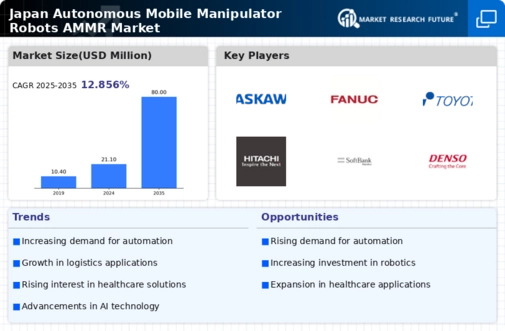Aging Population
The Global Japan Autonomous Mobile Manipulator Robots Market AMMR Market Industry is significantly influenced by the aging population in Japan. As the demographic landscape shifts, there is an increasing need for solutions that can assist the elderly in daily activities. AMMRs are being developed to provide support in healthcare settings, such as hospitals and nursing homes, where they can assist with patient care and mobility. This demographic trend is expected to drive demand for AMMRs, as they offer a viable solution to address labor shortages in the healthcare sector. The market is poised for growth, reflecting the changing needs of an aging society.
Rising Labor Costs
The Global Japan Autonomous Mobile Manipulator Robots Market AMMR Market Industry is also shaped by the rising labor costs in various sectors. As wages increase, companies are seeking cost-effective solutions to maintain profitability. AMMRs present an attractive alternative, as they can perform repetitive tasks efficiently without the need for breaks or benefits. This economic pressure is prompting businesses to invest in automation technologies, including AMMRs, to optimize their operations. The financial implications of labor costs are likely to drive the market's growth, as organizations recognize the long-term savings associated with deploying autonomous robots.
Market Growth Projections
The Global Japan Autonomous Mobile Manipulator Robots Market AMMR Market Industry is projected to experience substantial growth in the coming years. With a market value of 1250 USD Million in 2024, it is anticipated to expand to 3750 USD Million by 2035. This growth trajectory suggests a compound annual growth rate of 10.5% from 2025 to 2035. Such projections indicate a robust demand for AMMRs across various sectors, driven by technological advancements, increasing automation, and evolving market needs. The anticipated growth reflects the industry's potential to revolutionize operational practices and enhance productivity.
Technological Advancements
The Global Japan Autonomous Mobile Manipulator Robots Market AMMR Market Industry is experiencing rapid technological advancements, particularly in artificial intelligence and machine learning. These innovations enhance the robots' capabilities, enabling them to perform complex tasks autonomously. For instance, the integration of advanced sensors and computer vision allows these robots to navigate dynamic environments with precision. As a result, the demand for AMMRs in sectors such as logistics and healthcare is on the rise. This trend is expected to contribute significantly to the market's growth, with projections indicating a market value of 1250 USD Million in 2024, potentially reaching 3750 USD Million by 2035.
Global Supply Chain Challenges
The Global Japan Autonomous Mobile Manipulator Robots Market AMMR Market Industry is being impacted by ongoing global supply chain challenges. Disruptions in supply chains have highlighted the need for more resilient and flexible logistics solutions. AMMRs can enhance supply chain operations by automating material handling and inventory management, thereby improving efficiency and reducing delays. Companies are increasingly turning to AMMRs to mitigate risks associated with supply chain vulnerabilities. This trend is expected to bolster the market, as businesses seek to adopt technologies that can provide a competitive edge in an unpredictable global environment.
Increased Demand for Automation
The Global Japan Autonomous Mobile Manipulator Robots Market AMMR Market Industry is witnessing a surge in demand for automation across various sectors. Industries such as manufacturing, healthcare, and logistics are increasingly adopting AMMRs to enhance operational efficiency and reduce labor costs. For example, in manufacturing, AMMRs are utilized for material handling and assembly tasks, streamlining production processes. This growing inclination towards automation is anticipated to drive the market's expansion, with a projected compound annual growth rate of 10.5% from 2025 to 2035. The shift towards automated solutions is likely to solidify the role of AMMRs in modern industrial practices.






















Leave a Comment